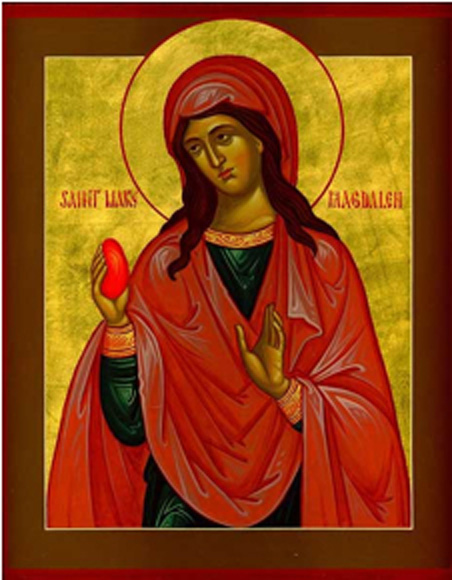Jesus and Mary Magdalene

A close reading of the gospels, particularly the crucifixion and resurrection accounts, suggests that Mary Magdalene had a prominent role in the ministry of Jesus. Indeed, she was often referred to as “the apostle to the apostles.” Of the many women disciples of Jesus, Mary of Magdala was by far the most significant to Jesus and to the movement he led.
In looking at Mary’s prominence in Jesus’ ministry and the role she played, it is useful to ask: given the way Mary is presented in the gospels, what must she have been like in real time to be the person she seems to be in the gospel stories? More, still, what must her relationship to Jesus have been like?
Mary Magdalene in the gospel stories. In the gospels, before Jesus’ crucifixion and resurrection, Mary is referenced only three times. First, in Luke 8, when Jesus was going through cities and villages proclaiming his message, Luke notes:
The twelve were with him, as well as some women who had been cured of
evil spirits and infirmities: Mary, called Mary Magdalene, from whom
seven spirit had gone out … . (Luke 8:8:1b-2)
A second and third reference are related by both Matthew and Mark (Matthew 26:6 and Mark 14:3). Jesus is at Bethany in the house of Simon the leper. As the Jewish authorities are plotting against him, a woman, thought to be Mary Magdalene, comes with an alabaster jar of expensive ointment and anoints Jesus.
In her recent book, Mary Magdalene Revealed, Meggan Watterson notes how anointing has to do with the integration of opposites (life and death, for example) into a higher state of consciousness. Amazing insight! In this regard, the words of Jesus–notably exalting of Mary–are telling:
Wherever this good news is proclaimed in the whole world, what she has
done will be told in remembrance of her. (Matthew 26:13)
The remaining references to Mary in the gospels are at Jesus’ crucifixion and resurrection. In effect, during these experiences of sadness and despair, and then hope, she is everywhere. At the cross and in the resurrection experiences (particularly in John 20), she is always there or hovering nearby. We have to ask ourselves, why would this be?
Mary and Jesus. In relation to Jesus, who was Mary? And what was her role? These questions have fascinated people, both in and outside the Church for ages. We all remember some years back when the book, The DaVinci Code came out, becoming an immediate bestseller. It was a story revolving around Jesus and the very real possibility that he had intimate relations with Mary Magdalene.
In her book, Meggan Watterson talks about how, in the Gospel of Philip, Mary is referred
to as the companion of Jesus. In Greek, the word is koinonos, which can translate as married partner, counterpart, beloved, or companion in faith. About Jesus and Mary, Philip goes on to say: he loved her more than all the disciples, and that, he often kissed her on the mouth, more than suggesting their partnership was also physical.
Watterson adds that what is important is not whether they had a sexual relationship; what is important is that they were a couple, a duo. In other words, they were a partnership. They were meant to be seen together, understood as a whole. Upon reading the Gospel of Mary Magdalene and other books on her, it is increasingly hard for me to imagine this was not the case. More importantly, Watterson says, is that we’ve forgotten and willfully buried this aspect of Christ, that he was in love with Mary. (from Watterson’s book, Mary Magdalene Revealed, 2019 by Hay House, p. 152)
In my effort to stress the importance of Jesus’ humanity over the years, I have often wondered about Jesus’ relationship with Mary Magdalene. I have always hoped they shared some level of intimacy in their relationship. If Jesus is fully human, who would not want him to be fulfilled as a human being in every way. To be human is to love and be loved. Sharing a love that is, at the same time, spiritual, physical, intellectual, and even mystical, would be a beautiful realization of what it means to be human.
In his book, Zealot, Reza Aslan underscores how it would have been extremely rare in the world of first century Galilee for a man not to have been married. Indeed, it would have been a public embarrassment to have not had a wife. It is also true that nowhere in the gospel accounts, nor elsewhere in the Christian Scriptures, is there any mention of Jesus having a wife.
However, having said that, we have to remember the gospels were written 40-70 years after Jesus’ death. As the years marched on after the resurrection, more and more, the emerging narrative tried to paint Jesus as perfect and without sin. For Jesus to have been in love with Mary, to say nothing of sharing intimate relations with her, would have been unacceptable to this narrative.
Mary’s special closeness to Jesus. What all of this suggests about Mary, and what we need to remember, is that because of her closeness to Jesus,
she was able to hear him, experience him, and meet him from within her own heart;
and that she had so much to teach us–that her love for him taught her. (Ibid, p. 12)
Imagine, having the love, the heart, and the soul to meet Jesus, to walk with him, to be his partner! What must that have been like? More than amazing! Adding still more depth and meaning to this, as Watterson points out in her book, we observe Mary at the cross and in the resurrection:
She wept at seeing the empty tomb. She needed to be with his body. She was
there when no one else was. She was the love that remained. (Ibid., p. 205)

